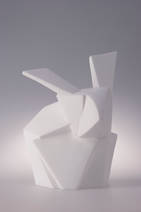

JACQUES OWCZAREK
Over the past twenty years, Jacques Owczarek has made a name for himself with collectors as one of the most talented sculptors of his generation. His singular and immediately recognizable "forms" as he calls them have traveled all over the world, from Paris to Shanghai, Abu Dhabi to New York, London and Moscow, praised and sought-after as pieces of a remarkable body of work. Offering a unique and unprecedented visual vocabulary on the artistic landscape, the self-taught artist clashes, surprises and stirs emotions with a razor-sharp truth, a no-frills sincerity that mirrors his sculptures. The soul – anima – is the inherent driving force of his astonishing animals that incarnate, no matter what angle you view them from, a striking verticality that is is received by the artist and recreated as if by "magic", a word dear to Jacques Owczarek. Here the material is taken far beyond itself, bursting with life, the essential, and the purity of line tells us just how obvious beauty is and how it raises us to our true selves. Text by Caroline Bongrand















Jacques Owczarek says himself that he was born at 30, the age he discovered sculpture. His tiny studio is tucked away at the back of a small courtyard on the legendary Rue Jacob in Paris, frequented by the likes of Victor Hugo, Balzac, Baudelaire or Jules Verne on visits to their publisher, or the site of the last literary salon hosted by Natalie Clifford Barney for guests such as Colette, Gertrude Stein and other writers. The premises are inhabited, and have been for many years. The location is not inconsequential, for it is steeped in culture and open to the world – so many of these names have reached far beyond their borders.









Jacques Owczarek’s studio is a similar source of great talent. It may be cramped, but there is no need to move between the two tables covered with a wild and spectacular world. His small workspace, a mere board on two trestles, is where the light falls and takes hold of his hands to create forms which, for a long time, remain unknown to the artist himself until he seems to recognize someone, or rather, an animal.
He says he lets the earth express itself in his work. There is no research involved, he just does. "Animals want to be born, they are breathing souls that impress themselves upon me."








He lets the forms impose themselves and come to life. Using no documentation whatsoever, the artist who does not visit zoos or consult wildlife books might initially see a monkey in what will finish as an elephant. Harnessing the power of pure poetry, he says he creates things he is incapable of creating. Which raises the question of what we are. Certainly more than bodies and minds, souls, and for some, genuine artists, powerful souls that link the visible and invisible, not the dark forces but the power of life that goes beyond what science can imagine and that one day we might be able to see with the naked eye. Jacques Owczarek, who cannot draw a line and is incapable of sketching, thus receives from a far-off world, a superior dimension, a form that develops as if by magic, beneath his fingers, a kind of incongruous yet perfect geometry, a sharply beautiful design upheld by a material that gives it even more striking power. The man who says he is primarily driven by "sensations" describes himself as an intermediary. What is important, to his mind, and the idea that is dear to his heart, the most vital component of life, is to find one's place. There is no doubt he has found his.
Caroline Bongrand

.png)